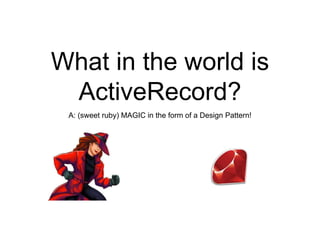Active Record PowerPoint
•Als PPTX, PDF herunterladen•
1 gefällt mir•528 views
Melden
Teilen
Melden
Teilen

Empfohlen
Empfohlen
Weitere ähnliche Inhalte
Andere mochten auch
Andere mochten auch (6)
Staying Secure When Moving to the Cloud - Dave Millier

Staying Secure When Moving to the Cloud - Dave Millier
2015 10 21_expo_sem_7-gian franco compagnoni - shotcrete

2015 10 21_expo_sem_7-gian franco compagnoni - shotcrete
Ähnlich wie Active Record PowerPoint
Ähnlich wie Active Record PowerPoint (20)
Rob Harrop- Key Note The God, the Bad and the Ugly - NoSQL matters Paris 2015

Rob Harrop- Key Note The God, the Bad and the Ugly - NoSQL matters Paris 2015
White Paper for OMG! Identifying and Refactoring Common SQL...

White Paper for OMG! Identifying and Refactoring Common SQL...
Agile Data: Building Hadoop Analytics Applications

Agile Data: Building Hadoop Analytics Applications
Introduction to CQRS - command and query responsibility segregation

Introduction to CQRS - command and query responsibility segregation
Into the Land of lambda, One Programmer's Journey Into Functional Programming

Into the Land of lambda, One Programmer's Journey Into Functional Programming
Agile Data Science by Russell Jurney_ The Hive_Janruary 29 2014

Agile Data Science by Russell Jurney_ The Hive_Janruary 29 2014
Active Record PowerPoint
- 1. What in the world is ActiveRecord? A: (sweet ruby) MAGIC in the form of a Design Pattern!
- 2. Let’s start with SQL! Wait what? That’s not ActiveRecord • SQL stands for Structured Query Language • There are a ton of different SQL Databases!!
- 3. • SQL lets you manage data in a relational database • Insert - Create a new row of information in a table • Update - Change information in an existing row • Select - Retrieve information in a table • Delete - Remove a row in a table • SQL uses data types such as String, Text, Integer, Date, Time • An SQL query looks like this: SELECT * FROM cats WHERE cats.breed = ‘Sphynx’; How does SQL even…?
- 4. Doing it the Ruby Way Active Record Pattern Convention over Configuration (CoC) Don’t Repeat Yourself (DRY) Model-View-Controller (MVC) • Some Frameworks require you to write a lot of configuration code. • Rails Adopts Conventions so you don’t have to! 1. Naming Conventions 2. Schema Conventions 3. Query Interface Ruby on Rails Guides: http://guides.rubyonrails.org/active_record_basics.html#convention-over-configuration-in-active-record
- 5. What’s an ORM? • ORM stands for Object Relational Mapper • Maps database to ruby object • They get rid of SQL queries in code SELECT * FROM cats VS Cats.all • Essentially ActiveRecord takes ruby code and translates it into SQL code. Hint: Active Record is Ruby’s way of dealing with ugly SQL!
- 6. Active Record is the “M” in MVC model: DOGGIE id name color spotted adorable age 1 Chowderhead tan and white FALSE TRUE 1 2 Paco snow white FALSE TRUE 3 3 Tenley brown and white spots TRUE TRUE 5 Models are Ruby classes. • They talk to the database • Store and validate data • Performs the logic of knowing about an instance of itself So… what is a MODEL anyway??
- 7. Active Record Relationships How Do Models Connect with Each Other? Lets start easy: A Supplier has one Account (This is a One-to-One Relationship)
- 8. Alternately, an Order belongs to a Customer (Also, a One-to-One Relationship) More Active Record Relationships
- 9. And when a Doctor has many Patients, but a Patient has many Doctors too! …and they both have many Appointments!
- 10. So Why Associations? • Make ugly SQL statements Ruby-Friendly: SELECT surveys FROM surveys JOIN ON users WHERE user.name LIKE “Dicko” —becomes— dicko = User.find_by_name(“Dicko”) dicko.surveys • We are basically making wonderful Ruby Methods with each association we declare! • Remember: IT ONLY LOOKS LIKE MAGIC (it never is)